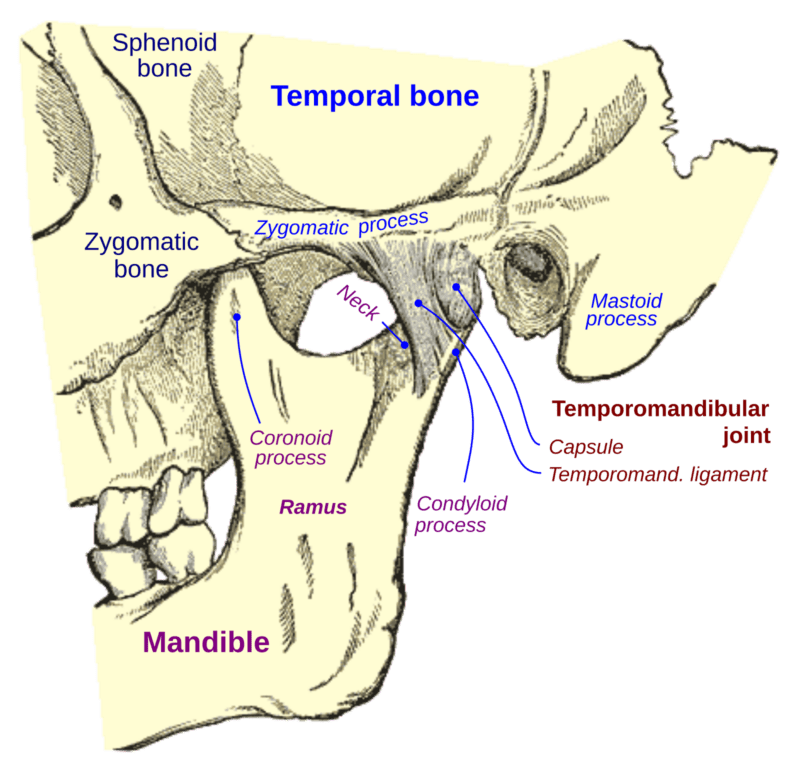Zany: I’m sharing this article because I have suffered with TMJ (temporomandibular joint) pain for 15 years or more. People who haven’t experienced TMJ pain will never understand. It comes from the joint where the jaw bone attaches to the skull and facilitates its movement. The pain from that joint radiates throughout the entire skull causing excruciating headaches, pain on both sides of the face, inside the ears, and moving down the neck and spine. I have 3 children, and I would say that TMJ pain rivals labor. Same intensity, different area of the body.
When I would experience a flare-up (brought on by chewing gum, eating hard, crunchy foods, or simply talking too much.), I could barely talk, definitely couldn’t eat, and would vomit from the intense pain on the sides of my face going into my ears. I could sometimes find relief by putting something between my teeth and just letting them rest on it. Holding my jaw in a certain position would alleviate, but not stop, the pain.
Like the people in this piece, I wanted to find relief. However, medical insurance doesn’t cover TMJ issues because they classify it as a dental condition. Dental insurance doesn’t cover it because they classify it as a medical condition (Hello? Congress?) Surgery is a common treatment, but researching it I learned that it doesn’t always work and in some cases makes it worse. I did not like those odds!
Over three decades of relentless pain, Jonna Tallant has tried about every TMJ treatment: mouthguards, six sets of braces, dental crowns and appliances, drugs, physical therapy, Botox, massage, acupuncture, chiropractic care, and surgery.
Nothing has helped. Tallant, 51, of Knoxville, Tennessee, said she lives in agony and cannot eat any food that must be chewed. Despite spending a small fortune on treatment, she can barely open her mouth enough to squeeze in a toothbrush.
Tallant estimates she has paid at least $200,000 for TMJ care. She provided medical records showing more than $60,000 in out-of-pocket spending in just the past decade. She has exhausted her savings and borrowed money, she said, and her family sold a plot of land to help pay the bills.
Tallant will need another jaw surgery later this year, which could cost as much as $75,000. Her insurance is unlikely to pay for any of it, she said.
“It’s a bottomless pit,” Tallant said, choking up, as she leafed through a pile of medical records splayed on her dining table. “It has consumed so much of my life that there is not much left.”
Temporomandibular joint disorders, known as TMJ or TMD, cause pain and stiffness in the face and jaw and are believed to afflict as many as 33 million Americans. Scientific studies have found that women experience TMJ disorders two to nine times as often as men, and while minor symptoms may not require treatment, severe symptoms can include disabling pain that makes it challenging to eat, work, talk, or sleep.

Despite the commonness of TMJ disorders, treatments are often not covered by medical or dental insurance, leaving patients with out-of-pocket bills that can range from a few hundred dollars to tens of thousands of dollars. Many medical insurers consider TMJ treatment too dental-focused for medical insurance, while dental insurers consider it too medical for dental insurance, leaving patients stuck in a “medical-dental divide” that hinders care and increases cost, according to the National Academies of Science, Engineering, and Medicine.
Worse still, researchers warn that the meager insurance coverage available for TMJ often excludes the safest forms of care while steering patients toward surgery — a riskier and irreversible option that the National Institutes of Health recommends “staying away” from.
Terrie Cowley, a longtime TMJ patient who leads the TMJ Association, an advocacy group, has spoken with patients who refinanced their homes and cashed out retirement accounts to afford the out-of-pocket costs for their care.
“It bankrupts them,” Cowley said. “But it isn’t nearly as horrible as when the treatments go wrong.”
Insurance woes are just one facet of the problems with TMJ care in the United States. In April, a joint investigation by KFF Health News and CBS News found that TMJ disorders have been widely misunderstood by many dentists for decades, so some patients fall into a spiral of ineffective care and futile surgeries that do more harm than good. Dentistry has tried to correct course in recent years with the promising new specialty of orofacial pain, which treats TMJ disorders with a more conservative approach, but these specialists are few and rarely covered by insurance, so their services remain beyond the reach of many patients.
Tony Schwartz, president of the American Board of Orofacial Pain, said the specialty is still fighting for widespread acceptance from insurance companies and some dentists, who cling to “old, debunked theories” that TMJ disorders are caused by misaligned teeth or a bad bite.
“This is the basis for why insurance companies have been so reluctant to, over the years, pay for any treatment,” Schwartz said. “Because there has been so much controversy about what works and what doesn’t work.”
For this article, KFF Health News and CBS News interviewed 10 patients with severe TMJ disorders who have been in treatment for years, if not decades. Almost all the patients described spending thousands of dollars out-of-pocket at every stage of their care, usually because treatment fell outside their medical and dental insurance coverage. Some patients said their medical bills mounted just as debilitating pain forced them to leave jobs or abandon careers. Some underwent expensive TMJ surgeries offered by only a small group of surgeons who generally do not accept insurance.
TMJ pain is debilitating
Kyra Wiedenkeller, 45, of New York state, said she worked as a manager in the music industry, including on “American Idol,” before her “unrelenting pain” became too great.
Wiedenkeller, who is now on disability, said she’s spent at least $100,000 out-of-pocket on TMJ treatment and provided medical documents showing she had been billed for at least that much.
“Every doctor I’ve seen has made me progressively worse,” Wiedenkeller said. “I paid an exorbitant amount of money. I wiped out my 401(k) for these treatments in hopes of getting better time and time again. And just get worse and worse. I feel like there is no end.”
Wiedenkeller’s story echoes findings of the national academies, which conducted a comprehensive study of TMJ in 2020 that included input from more than 110 patients. The study found that TMJ patients are “often harmed” during “overly aggressive” treatment, which frequently falls into a chasm between medical and dental insurance, leaving most bills paid out-of-pocket at costs of up to tens of thousands of dollars.
As an example, the study describes how dental splints — a common TMJ treatment — have been considered to be medical care by some dental insurers and considered dental care by some medical insurance programs, and are “therefore not covered” by either.
And when TMJ is covered by insurance, it tends to exclude “low-risk, effective treatments,” like those used by orofacial pain specialists, but covers “higher-risk” options, like jaw surgery, according to the national academies study.
Other researchers have come to the same conclusion.
James Fricton, an orofacial pain specialist who studies the lack of insurance coverage for TMJ care, said that even though surgery is appropriate for few patients, it is the only treatment covered by most insurance plans in most states.
“Patients will assume that insurance companies know what they’re doing,” Fricton said. “If that’s all that’s covered, what do you think they are going to get? Surgery.”
In contrast, insurance coverage appears to be weakest at the other end of the treatment spectrum.
“Orofacial pain,” officially recognized by the American Dental Association in 2020, is now taught in residency programs at a dozen U.S. colleges at least, including the universities of Michigan, Minnesota, and North Carolina. The specialty avoids making irreversible changes to the bite or jaw and instead treats TMJ disorders with tools like counseling, dietary changes, medication, physical therapy, and removable dental splints. Many TMJ patients can be treated by orofacial pain specialists for a few thousand dollars.
The national academies study describes this approach as one of the few promising options for TMJ patients, citing studies that showed improvement among patients who are taught how to manage their pain. But the national academies also said it is a “particular challenge” that this treatment is “often not considered reimbursable by insurance.”
In separate interviews, six orofacial pain specialists with clinics around the country said insurance coverage for this specialty care is patchy, poor, or nonexistent. Several said their specialty is often absent from dropdown menus on standard insurance forms. Most said the insurance industry had fallen behind on the evolving science of TMJ, missing a chance to help patients and cut costs.
“It’s a no-brainer,” said Jeffrey Okeson, dean of the University of Kentucky’s College of Dentistry. “If I was an insurance person, I’d want to supply $1,000 to a patient to do conservative treatment … instead of $15,000 or $30,000 for surgery. Think of the money that can be saved there.”
Okeson and the other orofacial pain specialists said unreliable insurance coverage has hamstrung the specialty by making it less attractive to the next generation of dentists.
Currently there are fewer than 300 certified orofacial pain specialists in the United States, according to a database maintained by the American Board of Orofacial Pain. At least 20 states have no certified specialists, and eight other states have only one or two.
Deepika Jaiswal, the only certified specialist in Iowa, said some patients with TMJ disorders drive across the state to see her.
However, most of her patients — and many of her fellow dentists — remain unaware of the orofacial pain specialty, Jaiswal said, so insurance companies likely feel little pressure to include it in their coverage.
“People don’t even know around the area that we exist,” Jaiswal said. “When there are more providers providing this service, I think at that point there will be more insurance.”
CBS News producer Nicole Keller contributed to this article.
Excerpts or more from this article, originally published on KFF Health News appear in this post. Republished, with permission, under a Creative Commons License.









